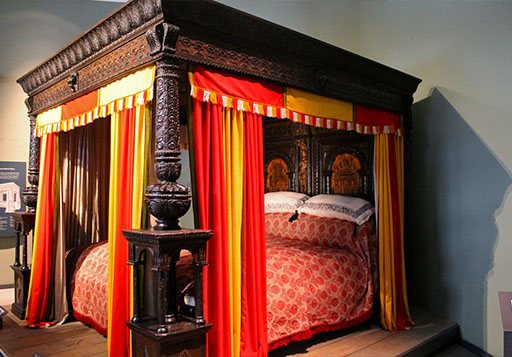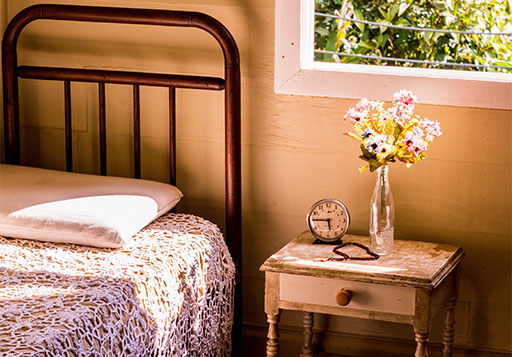Colour yourself sleepy: A look at colour therapy

Author: Jonathan Warren
The effect of colour on our mood has been explored in several ways, and for hundreds of years. It has the ability to make us feel warm or cold, uplifted or calm, and has even been discussed as a treatment for illness by several published works including the snappily-titled The Influence Of The Blue Ray Of The Sunlight And Of The Blue Color Of The Sky 1876 by General A. J. Pleasonton.
But how can we use this connection between ourselves and colour to improve the time we spend in our wooden, metal or upholstered beds ?
Although the modern bedroom is used for many things including working, watching TV and even eating and exercising, we should all aim to view our bedroom as a restful haven that we associate with sleep. Therefore, the décor we choose should promote a relaxed, calming atmosphere that allows us to escape from the distractions and stresses of everyday life. Some colours deliver this air of calm, while others could have you tossing and turning all night…
Colours to avoid:
Red and dark purple should not be used in the bedroom. They are both stimulating colours that can set the mind racing, making it almost impossible to feel restful.
Bright yellow is loud and cheerful and looks lovely when the sunlight pours into the room, but for an end-of-day retreat, the colour is not ideal. If you have your heart set on yellow, choose more muted sorbet shades.
Colours to go for:
Light blues and lavenders are the optimum choices for the bedroom as they have a calming effect on the mood. While any pale colour - such as white or cream - is more relaxing than a bright shade, it can leave a room a little lacking in personality, so delicate colours could be a better option.
?
Although the modern bedroom is used for many things including working, watching TV and even eating and exercising, we should all aim to view our bedroom as a restful haven that we associate with sleep. Therefore, the décor we choose should promote a relaxed, calming atmosphere that allows us to escape from the distractions and stresses of everyday life. Some colours deliver this air of calm, while others could have you tossing and turning all night…
Colours to avoid:
Red and dark purple should not be used in the bedroom. They are both stimulating colours that can set the mind racing, making it almost impossible to feel restful.
Bright yellow is loud and cheerful and looks lovely when the sunlight pours into the room, but for an end-of-day retreat, the colour is not ideal. If you have your heart set on yellow, choose more muted sorbet shades.
Colours to go for:
Light blues and lavenders are the optimum choices for the bedroom as they have a calming effect on the mood. While any pale colour - such as white or cream - is more relaxing than a bright shade, it can leave a room a little lacking in personality, so delicate colours could be a better option.
 ?
Although the modern bedroom is used for many things including working, watching TV and even eating and exercising, we should all aim to view our bedroom as a restful haven that we associate with sleep. Therefore, the décor we choose should promote a relaxed, calming atmosphere that allows us to escape from the distractions and stresses of everyday life. Some colours deliver this air of calm, while others could have you tossing and turning all night…
Colours to avoid:
Red and dark purple should not be used in the bedroom. They are both stimulating colours that can set the mind racing, making it almost impossible to feel restful.
Bright yellow is loud and cheerful and looks lovely when the sunlight pours into the room, but for an end-of-day retreat, the colour is not ideal. If you have your heart set on yellow, choose more muted sorbet shades.
Colours to go for:
Light blues and lavenders are the optimum choices for the bedroom as they have a calming effect on the mood. While any pale colour - such as white or cream - is more relaxing than a bright shade, it can leave a room a little lacking in personality, so delicate colours could be a better option.
?
Although the modern bedroom is used for many things including working, watching TV and even eating and exercising, we should all aim to view our bedroom as a restful haven that we associate with sleep. Therefore, the décor we choose should promote a relaxed, calming atmosphere that allows us to escape from the distractions and stresses of everyday life. Some colours deliver this air of calm, while others could have you tossing and turning all night…
Colours to avoid:
Red and dark purple should not be used in the bedroom. They are both stimulating colours that can set the mind racing, making it almost impossible to feel restful.
Bright yellow is loud and cheerful and looks lovely when the sunlight pours into the room, but for an end-of-day retreat, the colour is not ideal. If you have your heart set on yellow, choose more muted sorbet shades.
Colours to go for:
Light blues and lavenders are the optimum choices for the bedroom as they have a calming effect on the mood. While any pale colour - such as white or cream - is more relaxing than a bright shade, it can leave a room a little lacking in personality, so delicate colours could be a better option.



